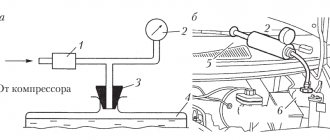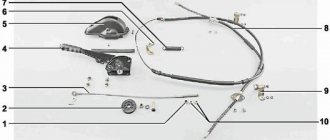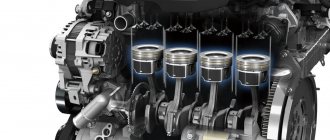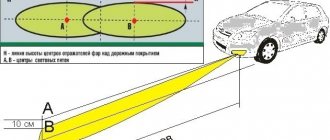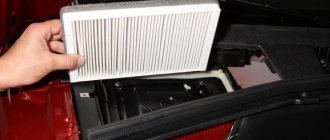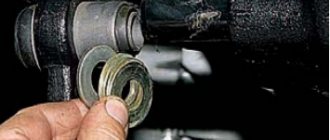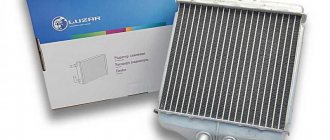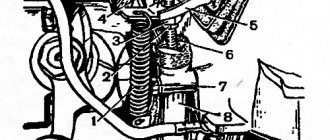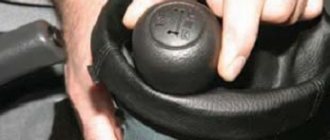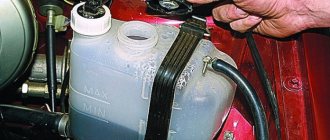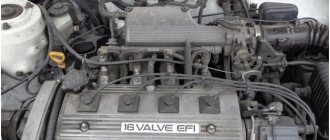To love in Russian: repair and maintenance of Chevrolet Niva
The owner of our current Niva, when choosing a car, hesitated between Renault Sandero Stepway and Chevrolet Niva. During a test drive at a car dealership, the Niva’s trunk did not open, gears were difficult to shift, and when I tried to brake urgently, the car stalled, and no one could start it for several minutes. And yet the choice was made in favor of Niva. Why? I won’t answer you anything here; even the owner of this Niva couldn’t give a clear answer. I like it, and that’s it! This happens, doesn’t it?
A little bit of history
Chevrolet Niva was a logical continuation of the classic Niva VAZ-2121. At one time, this car could be called one of the most successful Soviet cars. A lot of materials of varying degrees of quality and objectivity are devoted to the history of its origin, so let me skip today the history of the creation of the Niva. Let's go straight to the Chevrolet one.
The VAZ-2121 was good for everyone, but especially outside the city limits. The time has come, and driving an old Niva around the metropolis was simply awkward, especially since various Suzuki Vitars and other Toyota RAV4s began to slip through the traffic more and more often. The sight of foreign representatives of the then new SUV class caused bouts of greening of the skin of the Niva drivers, and in the end it became clear that the Niva would have to be modernized. Now, when crossovers have turned into hatchbacks with plastic door sills, people have realized that they shouldn’t have liked “honest” SUVs, but then everything was different...
In 1998, when a little more than 20 years had passed since the production of the VAZ-2121, AVTOVAZ designers presented the VAZ-2123 to the world. At that time, the word “Chevrolet” was not in the name; the car was called Niva II. Inside the more or less modern-looking body was the same old Niva, albeit with significant alterations, especially in the transmission. During this difficult time for the country in general and for AVTOVAZ in particular, it was not possible to organize the production of a new car. From 1998 to 2002, the VAZ-2123 was assembled only in small batches in pilot production. Most likely, God would have had mercy, but in 2002 we managed to come to an agreement with General Motors, a joint venture GM-AvtoVAZ was created, as a result of which a Chevrolet badge appeared on the Niva’s lining, and Niva became a trademark of the joint production. The classic Niva has since been produced under the name Lada 4x4. In 2009, the Chevrolet Niva experienced its first and last restyling, although it did not change radically. More important is the fact that during the production of the car since 2002, many components changed periodically, which is why the car gradually became better and better. A little later we will look at what you could buy in 2012, but for now let’s note this. Like any car, the Chevy Niva has both ardent supporters and haters. And this is explained, first of all, by the instability of quality. Almost 95% of the components in the car are domestic, the assembly is also local, and despite the patronage of GM, within the same batch there were both completely problem-free cars and those that literally fell apart on the move. Especially in the first years of production. Although there is a story circulating on the Internet about a Niva that drove and did not break down at all for four years. It is difficult to vouch for the veracity, but the likelihood of such a development of events exists.
One way or another, the Chevrolet Niva has won its share of consumer love. Of course: for its price it was impossible to buy something more passable imported, but some level of comfort is still present. During the 2009 restyling, we even managed to draw a quite nice interior.
Engine
The power unit of the Chevrolet Niva originates from the good old carburetor engine 21213 of the first Niva. Of course, a lot has changed over time, but looking at the engine of today’s Chevrolet Niva, it’s hard not to remember its venerable ancestor. The modern VAZ-2123 engine is an injection engine, and another innovation of the engine is a hydraulic compensator mechanism.
Due to the specific nature of the car, owners quite often handle its maintenance themselves - the design is not the most complex, and it will not present any surprises to those who are familiar with domestic technology. Therefore, we will not describe in detail, for example, the procedure for changing the oil or air filter - everything is simple and clear.
The oil filter is traditionally located on the side of the block, access to it is not the most convenient, but you can unscrew it. Its cost is from 400 to 600 rubles. You will need 3.75 liters of oil. To unscrew the drain plugs, you will need a hexagon, you will have to look for the plug itself, but a standard boot allows you to unscrew it without removing the boot itself. Inconvenient, but possible. Thanks to the high ground clearance, you can even do without a pit or lift, especially since the plug is located in front of the engine. If the car has more serious crankcase protection installed, then it is still better to raise the car.
Now that the hood is open, let's see what else can bring surprises. Many Chevrolet Niva owners are faced with the problem of a burst expansion tank. This happens for two reasons. Firstly, the shape of the tank itself is not very good: it is rectangular with side surfaces of a fairly large area, which do not like differences in coolant pressure. The second reason lies in the unstable quality of the reservoir cap, the valves of which do not always adequately respond to pressure changes in the cooling system. If suddenly the car starts to “boil” or a crack appears on the second tank in a row, you should pay attention to the plug.
There is a problem worse than a reservoir plug - the hydraulic timing chain tensioner. It doesn’t always cope with the job on its own, but sometimes it also has a desire to stop working altogether due to a burst oil supply pipe. The first sign of unsatisfactory operation of the hydraulic tensioner will be a metallic clanging sound. On engines after 2008, the mechanism was slightly changed and the diameter of the oil tube was increased. However, the problem has not completely gone away, so many people prefer to replace the hydraulic tensioner with a mechanical one. There is already an ISAI tensioner here, which does not require adjustment as the chain stretches (at least, that’s what the device manufacturer claims). Such a thing costs only 1,000 rubles, but, according to many Niv owners, it significantly increases the reliability of the chain drive. The chain itself can last about 100,000 kilometers before replacement. The hydraulic compensators of the engines of the first Nivas made us want to replace them with regular adjusting bolts. Now the situation with hydraulic compensators has improved significantly, although most drivers consider the noise in the cylinder head that occurs on many vehicles during a cold start of the engine to be the norm. Before replacing the alternator belt, you need to determine how its tension is adjusted. On some cars, it is adjusted by displacing the generator (as on the “classic”), on later cars a tension roller appeared (the generator in the latter case is located on top, to the left of the engine). In general, under the hood we note a fairly convenient layout for carrying out minor repairs and maintenance. Replace the headlight bulbs, the air filter (you only need a Phillips screwdriver), add fluid - it's all simple. Although, for example, you will have to suffer with removing the starter.
Transmission and chassis
What cannot be taken away from the Niva is honest all-wheel drive. From time to time, some comrades have a desire to make the all-wheel drive switchable, and then the limit of intervention in the design is limited only by laziness and imagination. Most often, they simply remove one of the cardans (mainly the front one), and especially hardworking owners install axle shut-off blocks. It seems that all these actions are from the evil one, but it is necessary to know that such “tuned” cars are found in nature. If you suddenly want to buy a used Chevrolet Niva, ask if the previous owner abused trips without one cardan. If yes, check the car for increased vibrations due, for example, to the “death” of the transfer case supports. It was not possible to collect significant statistics on transmission and transfer case breakdowns, which indirectly indicates their good reliability, but complaints about the clutch drive arise quite often. It is hydraulic, and both the main and slave cylinders of the clutch have to be changed. From time to time, the toad attacks the owner of the Niva with his entire heavy body, and he repairs the cylinders, fortunately you can buy repair kits. By and large, all this is a relic of the “deep antiquity”, when we also riveted brake linings for drum mechanisms. Now it is more expedient to replace these mechanisms entirely, fortunately they cost pennies in today’s money: from 400 to 600 rubles. Replacing each cylinder at a service center will cost 800 rubles, but anyone who remembers how to bleed the clutch can do this work on their own. However, those who remember will definitely take an assistant: no one has ever managed to twist the fittings and press the pedal at the same time.
There is one significant difference in the transmission between cars produced before 2010 and later ones. After 2010, new shafts with constant velocity joints were installed. As a result, anthers appear, the condition of which will have to be closely monitored. To the credit of the early design, we note that it is easier to remove and install the cardan: just unscrew four bolts on each side. To remove the shaft with CV joints, you will need to hang out the transfer case. Of course, to replace the boot, you will also have to tinker with the transfer case, and the boot itself will cost 200-300 rubles, and the replacement price will be much higher and will greatly depend on the moral qualities of the service station masters. When changing oil in boxes and gearboxes, it is permissible to use one 75w-90 gear oil. The gearbox will contain 1.6 liters, the transfer case – 0.79 liters, the front axle gearbox – 1.15 liters, the rear axle – 1.3 liters. The weak point of the chassis is the wheel bearings. The mileage of our car is only 34 thousand, but they have already been changed. The cost of bearings starts from 400 rubles, the average replacement cost is 1,500. Well, as for the rest... Let us remind you once again: the Niva is an SUV, so its suspensions are usually not taken care of. And the life of the chassis will greatly depend on where and how this car usually drives. It makes sense to pay attention to the following detail.
1 / 2
2 / 2
The standard engine crankcase protection is installed in such a way that the arms and silent blocks of the front suspension remain unobstructed. If this is not so scary on an ordinary car, then for an SUV this fact can become a reason for sadness and serious repairs to the chassis after unsuccessful “off-road tests”.
If you pull off the road with the words “guys, look how I can!” and rest the lever against the first stump or pebble, then the repair prices will be approximately as follows. Lower arm - 3,900 rubles, steering rod - 800, replacement of the lever - 1,600, replacement of the rod - 700, installation of camber and toe angles - 2,000 rubles. Let's move on to the "curiosities" section. The mileage, as I already said, is small - 34 thousand. Age – four years. Do you know what rotted the car during this time? Brake discs. They were so rusty that they had to be replaced. The disk will cost 2,200 rubles, its replacement - 800. We will assume that the corrosion appeared solely from low mileage, because the car should not stand, but drive. And preferably more.
Body and interior
First, we will sit in the car as usual and see how it drives. And we immediately understand that the character from the cartoon and games depicted on the spare wheel box comes in handy here. For those who don't know, his name is Slowpoke, and he's known for being slow.
The owner of the Niva, who has a good sense of humor and the ability to soberly assess the capabilities of his car, chose the picture very accurately. Indeed, 80 horsepower is very, very little, especially for a car whose all-wheel drive transmission can “gobble up” a decent amount of “horses” from an already not very powerful engine. But on the other hand, the Chevrolet Niva is not designed to win races. Her task is to go where others cannot go. And she copes with it, even in stock condition. Of course, it’s better to drive on the highway no more than a hundred kilometers per hour, and then only while enjoying the vibrations and hum of the transmission. In the city, she likes to eat liters of gasoline, but all this is the price for permanent all-wheel drive. But the interior of the 2012 Niva looks quite decent. Small innovations (steering wheel, dome light and other little things) make the interior much more pleasant compared to pre-restyling cars. There are, of course, places where I would like to put my hands: for example, the transfer case and gearbox levers here remain pulled out of Elton John’s bold fantasies, and the tidy from the “tag” now looks like a complete anachronism.
But in general, the interior does not cause rejection. Especially if you remember the cost of this car, because even against the backdrop of rising prices, the Niva remains the most affordable SUV. In a word, we won’t criticize the interior: it’s simple, but not noisy, not repulsive, and an attempt on fashion. It’s better to get down to business: what you need to know about the body and interior of the Chevrolet Niva.
1 / 5
2 / 5
3 / 5
4 / 5
5 / 5
The Niva's sills under the plastic covers almost immediately begin to rot, and the most careful owners remove these covers in order to apply preventive measures immediately after purchase. Another problematic place is under the door seals, where “saffron milk caps” also appear quite often. Unfortunately, Niva’s paintwork cannot be called high quality. Behind him there is only an eye and an eye. Those who like to ride over holes, bumps and mud will have to carefully monitor the rear bumper: from the inside it is made so “successfully” that it resembles a bucket shape. And the ladle, as you know, is perfectly suited for scooping up everything that catches on.
What's the result?
There are no perfect cars. Moreover, specialized ones, which include the Chevrolet Niva. On the highway it is quite difficult to overtake; in the city the gas mileage will be disappointing. But you can drive where many crossovers won’t even go. And this is the advantage of such a car. Some people may not like the fact that the car will require increased attention to certain places and components. But it doesn’t cost as much as a Cadillac Escalade , and its maintenance and repairs may be too frequent, but not very expensive.
You might also be lucky and your Niva won’t break down. Remember when we said that such instances also exist? The frankly archaic design also has its advantages. Firstly, you can do a lot yourself. Secondly, the services are usually not impudent with prices. Thirdly, spare parts are plentiful everywhere. Fourthly, everything or almost everything is already known about repairing the Niva on our own. True, you will have to put up with a chronically leaking oil filler plug of a typical “Zhiguli engine”, with rusting “hardware” or a sudden failure of just about anything. But nothing newer and more modern has yet been invented for off-road driving.
For assistance in preparing the material, we express our gratitude to IP Butorin (auto, St. Petersburg, Fuchika St., 17, box No. 1)
Body and interior of Niva Chevrolet …………………….4
- Car keys……………………..4
- Remote control system….5
- Chevrolet Niva instructions for replacing the battery of the key with remote control………………………..8
- Doors……………………………………………………………9
- Seats………………………………………………………11
- Adjusting the steering wheel position……………………12
- Seat belts………………………..13
- Airbags…………………14
- Safety of infants and small children …………………………..17
- Installing a child seat……………18
- Interior equipment Chevrolet Niva operating manual……………19
- Hood…………………………………………………………..21
- Fuel tank cap………………….21
Is the gear selection mechanism from Classic suitable for VAZ 2123?
In the modern world of developed technologies, equipment and a huge number of spare parts offered by stores, garage buyers and tuning enthusiasts have access to any actions to repair, constructively alter and modernize their cars.
The manual transmission for the VAZ-2123 car is based on the classic gearbox for the VAZ-2107 with several differences:
- the designer excluded the installation of restrictor rings at the end of the secondary shaft;
- a modern spacer bushing has been installed to provide the speedometer drive function;
- The idler gear axis is fixed separately on the manual transmission housing.
If you are faced with a breakdown of the factory gearbox on a Shnivy, and buying a new unit is too expensive, then you can choose a good used version of the classic gearbox and make several modifications yourself.
Tips for replacing the gearbox
Initially, it is necessary to dismantle the factory gearbox with all adjacent mechanisms (muffler, cardan shaft and exhaust shaft). Dismantling is carried out with speed 1 turned on. To install a 4-mortar from a classic, you will also need to rearrange the gear shift assembly itself (shift lever and rocker), and the reverse gear release tab (for this you will have to remove the rear cover).
When moving the gear selector from one gearbox to another, we recommend changing the restrictive retaining ring.
You will have to tinker a little with the rear support crossmember of the gearbox to the body because... classic won't do. The hole for the speedometer cable can be plugged with a rubber seal selected to size.
Useful! When replacing the gearbox, it is recommended to replace all seals and gaskets. Also, with the speed release assembly removed, pay attention to the condition of the clutch release bearing. If necessary, it is easier to replace it while everything is disassembled and accessible.
Replacing the timing belt
The condition of the timing belt is assessed every maintenance for damage and tension force, which should not exceed 0.8 per 10 kgf. Replacement is recommended after 15 thousand km.
- Remove the engine cover
- Perform a visual inspection of the timing belt for damage and tension.
- If replacement is necessary, remove the tension roller bracket
- Replace the timing belt according to the marks
Overcoming a deep puddle
Often a dispute arises between motorists about how best to cross a ford with a transfer case. Some people prefer to “fly” into a puddle from acceleration, others prefer to downshift. If you get into a mud pit, there is a high risk of water hammer - water gets into the cylinders through the filter, and the engine “chokes.”
To exclude this, many install a special snorkel. But you can do without it. A deep puddle should be overcome in second low gear. This is done so that in case of trouble (when the car starts to fail) you can switch to first gear in time and not stall. If you enter the water from acceleration (which is a better decision), remember that the wheels may get stuck in the middle of the journey. The engine power is not enough to turn the wheels - the car stalls, and the engine experiences a hydraulic shock.
Operating a vehicle in different modes
Its operating principle is quite simple. It consists in transmitting torque from the transmission to the drive shaft. Next, the forces are transferred to the center differential.
This mechanism can operate in five modes:
- Neutral is on.
- The differential is unlocked when the "lowering" is turned off. In this case, the torque is distributed in a ratio of one to two.
- The differential is locked when overdrive is engaged. Here, torque distribution is carried out automatically, depending on the quality of wheel grip on the road.
- Downshift is engaged and the differential lock is disabled. The transfer of forces occurs in the same ratio as in the first case.
- The differential is locked and the gearbox is engaged. In this case, all axles are rigidly locked together, including the axle shafts. Torque is produced unevenly, depending on the type of road surface (dirt, sand, etc.). In this mode of operation, the best cross-country ability of the vehicle is achieved. But driving with a constantly engaged downshift and with locks will not work. This increases the load on the transfer case bearings. The Chevrolet Niva will soon require serious intervention in the transmission. Fuel consumption also increases significantly, which greatly eats up the tires.
A lower gear is engaged when it is necessary to increase torque. An example would be driving up a steep slope or driving through sticky ground. To overcome difficult areas, the lock is activated. To achieve a clearer and more fixed engagement, you need to wait for the moment of slipping, and then, with the clutch disengaged, move the lever to the left. While locked, you can only travel a limited distance at a speed of no more than 40 km/h.
As an example, we can simulate the situation. To overcome an obstacle in the form of a large puddle, you should stop and engage a lower gear. Blocking is appropriate if there are bumps and rutting. It is not recommended to lock the differential unless necessary, as problems with unlocking often occur. If such a situation occurs, you need to start moving in reverse and at the same time try to move the lever to the right position.
Hanging the car diagonally will cause the free wheels to spin and the car will remain motionless. In this case, a lock is provided, which can be activated in overdrive mode. It should be noted that when overcoming steep descents, it is recommended to use engine braking. If the surface is covered with mud or snow, the first low gear mode is selected.
Replacing spark plugs
According to the requirements, spark plugs are replaced after 30 thousand km according to the manufacturer’s recommendation. AvtoVAZ recommends the following types of spark plugs: A17DVRM, BRISK “Super” LR17YC, LR15YC. The work is carried out in the following stages:
- Removing the engine protective screen
- Disconnecting the electrical wire
- Removing candles
- Installing new items
Replacing technical fluids
The selection of liquid temperature conditions is carried out based on operating conditions. Replacement must be done after reaching 60 thousand km. Procedure:
- Removing the drain plug on the radiator
- Removing the plug on the cylinder block
- Removing the hose from the throttle pipe
- Draining liquid
- Putting the plugs in place
- Filling the fluid until the throttle comes out of the hose
- Installing the hose on the pipe
Replacing brake fluid
The fluid must be replaced every 45 thousand km according to the manufacturer’s recommendation and is done as follows:
- Remove the reservoir cap
- Fill with brake fluid
- Bleed the brakes of each wheel one at a time.
Getting to know the car
The Niva belongs to the category of elegant SUVs, which were the first result of cooperation between Auto VAZ and General Motors. Driving along a city street can be safely called convenient and comfortable; the car is suitable for going to the country on weekends, or for a family trip with a group of three people. The car also feels at ease where a smooth road is replaced by an aggressive off-road. Among the features of the Chevy Niva are the following:
- new modern monocoque body;
- the engine is not connected to the front axle gearbox;
- all-wheel drive is permanent;
- unification of rear and front driveshafts;
- extension of the intermediate shaft;
- The design of the gearbox drive has been modernized, as well as the brake system.
